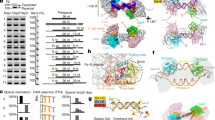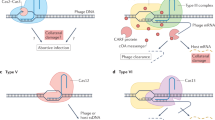Abstract
Archaea and bacteria harbour clustered regularly interspaced short palindromic repeats (CRISPR) loci. These arrays encode RNA molecules (crRNA), each containing a sequence of a single repeat–intervening spacer. The crRNAs guide CRISPR-associated (Cas) proteins to cleave nucleic acids complementary to the crRNA spacer, thus interfering with targeted foreign elements. Notably, pre-existing spacers may trigger the acquisition of new spacers from the target molecule by means of a primed adaptation mechanism. Here, we show that naturally occurring orphan CRISPR arrays that contain spacers matching sequences of the cognate (absent) cas genes are able to elicit both primed adaptation and direct interference against genetic elements carrying those genes. Our findings show the existence of an anti-cas mechanism that prevents the transfer of a fully equipped CRISPR–Cas system. Hence, they suggest that CRISPR immunity may be undesired by particular prokaryotes, potentially because they could limit possibilities for gaining favourable sequences by lateral transfer.
This is a preview of subscription content, access via your institution
Access options
Subscribe to this journal
Receive 12 digital issues and online access to articles
$119.00 per year
only $9.92 per issue
Buy this article
- Purchase on Springer Link
- Instant access to full article PDF
Prices may be subject to local taxes which are calculated during checkout




Similar content being viewed by others
References
Grissa, I., Vergnaud, G. & Pourcel, C. The CRISPRdb database and tools to display CRISPRs and to generate dictionaries of spacers and repeats. BMC Bioinformatics 8, 172 (2007).
Mojica, F. J. M. & Garrett, R. A. in CRISPR-Cas Systems: RNA-mediated Adaptive Immunity in Bacteria and Archaea (eds Barrangou, R. & van der Oost, J. ) 1–31 (Springer, 2013).
Mojica, F. J., Díez-Villaseñor, C., Soria, E. & Juez, G. Biological significance of a family of regularly spaced repeats in the genomes of Archaea, bacteria and mitochondria. Mol. Microbiol. 36, 244–246 (2000).
Jansen, R., Embden, J. D., Gaastra, W. & Schouls, L. M. Identification of genes that are associated with DNA repeats in prokaryotes. Mol. Microbiol. 43, 1565–1575 (2002).
Makarova, K. S. et al. An updated evolutionary classification of CRISPR-Cas systems. Nature Rev. Microbiol. 13, 722–736 (2015).
Brouns, S. J. et al. Small CRISPR RNAs guide antiviral defense in prokaryotes. Science 321, 960–964 (2008).
Van der Oost, J., Westra, E. R., Jackson, R. N. & Wiedenheft, B. Unravelling the structural and mechanistic basis of CRISPR-Cas systems. Nature Rev. Microbiol. 12, 479–492 (2014).
Westra, E. R. et al. The CRISPRs, they are a-changin’: how prokaryotes generate adaptive immunity. Annu. Rev. Genet. 46, 311–339 (2012).
Deveau, H. et al. Phage response to CRISPR-encoded resistance in Streptococcus thermophilus. J. Bacteriol. 190, 1390–1400 (2008).
Sinkunas, T. et al. Cas3 is a single-stranded DNA nuclease and ATP-dependent helicase in the CRISPR/Cas immune system. EMBO J. 30, 1335–1342 (2011).
Westra, E. R. et al. CRISPR immunity relies on the consecutive binding and degradation of negatively supercoiled invader DNA by Cascade and Cas3. Mol. Cell 46, 595–605 (2012).
Mojica, F. J. M., Díez-Villaseñor, C., García-Martínez, J. & Almendros, C. Short motif sequences determine the targets of the prokaryotic CRISPR defence system. Microbiology 155, 733–740 (2009).
Bolotin, A., Quinquis, B., Sorokin, A. & Ehrlich, S. D. Clustered regularly interspaced short palindrome repeats (CRISPRs) have spacers of extrachromosomal origin. Microbiology 151, 2551–2561 (2005).
Wiedenheft, B. et al. RNA-guided complex from a bacterial immune system enhances target recognition through seed sequence interactions. Proc. Natl Acad. Sci. USA 108, 10092–10097 (2011).
Xue, C. et al. CRISPR interference and priming varies with individual spacer sequences. Nucleic Acids Res. 15, 10831–10847 (2015).
Semenova, E. et al. Interference by clustered regularly interspaced short palindromic repeat (CRISPR) RNA is governed by a seed sequence. Proc. Natl Acad. Sci. USA 108, 10098–10103 (2011).
Vercoe, R. B. et al. Cytotoxic chromosomal targeting by CRISPR/Cas systems can reshape bacterial genomes and expel or remodel pathogenicity islands. PLoS Genet. 9, e1003454 (2013).
Fineran, P. C. et al. Degenerate target sites mediate rapid primed CRISPR adaptation. Proc. Natl Acad. Sci. USA 111, E1629–E1638 (2014).
Heler, R., Marraffini, L. A. & Bikard, D. Adapting to new threats: the generation of memory by CRISPR-Cas immune systems. Mol. Microbiol. 93, 1–9 (2014).
Amitai, G. & Sorek, R. CRISPR-Cas adaptation: insights into the mechanism of action. Nature Rev. Microbiol. 14, 67–76 (2016).
Nuñez, J. K., Lee, A. S., Engelman, A. & Doudna, J. A. Integrase-mediated spacer acquisition during CRISPR-Cas adaptive immunity. Nature 519, 193–198 (2015).
Yosef, I., Goren, M. G. & Qimron, U. Proteins and DNA elements essential for the CRISPR adaptation process in Escherichia coli. Nucleic Acids Res. 40, 5569–5576 (2012).
Pourcel, C., Salvignol, G. & Vergnaud, G. CRISPR elements in Yersinia pestis acquire new repeats by preferential uptake of bacteriophage DNA, and provide additional tools for evolutionary studies. Microbiology 151, 653–663 (2005).
Mojica, F. J. M., Díez-Villaseñor, C., García-Martínez, J. & Soria, E. Intervening sequences of regularly spaced prokaryotic repeats derive from foreign genetic elements. J. Mol. Evol. 60, 174–182 (2005).
Barrangou, R. et al. CRISPR provides acquired resistance against viruses in prokaryotes. Science 315, 1709–1712 (2007).
Bult, C. J. et al. Complete genome sequence of the methanogenic archaeon, Methanococcus jannaschii. Science 273, 1058–1073 (1996).
Lillestol, R. K., Redder, P., Garrett, R. A. & Brügger, K. A putative viral defence mechanism in archaeal cells. Archaea 2, 59–72 (2006).
Pul, U. et al. Identification and characterization of E. coli CRISPR-cas promoters and their silencing by H-NS. Mol. Microbiol. 75, 1495–1512 (2010).
Shah, S. A., Erdmann, S., Mojica, F. J. & Garrett, R. A. Protospacer recognition motifs: mixed identities and functional diversity. RNA Biol. 10, 891–899 (2013).
Fineran, P. C. & Charpentier, E. Memory of viral infections by CRISPR-Cas adaptive immune systems: acquisition of new information. Virology 434, 202–209 (2012).
Swarts, D. C., Mosterd, C., van Passel, M. W. & Brouns, S. J. CRISPR interference directs strand specific spacer acquisition. PLoS ONE 7, e35888 (2012).
Datsenko, K. A. et al. Molecular memory of prior infections activates the CRISPR/Cas adaptive bacterial immunity system. Nature Commun. 3, 945 (2012).
Li, M., Wang, R., Zhao, D. & Xiang, H. Adaptation of the Haloarcula hispanica CRISPR-Cas system to a purified virus strictly requires a priming process. Nucleic Acids Res. 42, 2483–2492 (2014).
Richter, C. et al. Priming in the Type I-F CRISPR-Cas system triggers strand-independent spacer acquisition, bi-directionally from the primed protospacer. Nucleic Acids Res. 42, 8516–8526 (2014).
Sesto, N. et al. A PNPase dependent CRISPR System in Listeria. PLoS Genet. 10, e1004065 (2014).
Touchon, M. & Rocha, E. P. The small, slow and specialized CRISPR and anti-CRISPR of Escherichia and Salmonella. PLoS ONE 5, e11126 (2010).
Díez-Villaseñor, C., Almendros, C., García-Martínez, J. & Mojica, F. J. M. Diversity of CRISPR loci in Escherichia coli. Microbiology 156, 1351–1361 (2010).
Kunin, V., Sorek, R. & Hugenholtz, P. Evolutionary conservation of sequence and secondary structures in CRISPR repeats. Genome Biol. 8, R61 (2007).
Toro, M. et al. Association of clustered regularly interspaced short palindromic repeat (CRISPR) elements with specific serotypes and virulence potential of shiga toxin-producing Escherichia coli. Appl. Environ. Microbiol. 80, 1411–1420 (2014).
Vorontsova, D. et al. Foreign DNA acquisition by the I-F CRISPR-Cas system requires all components of the interference machinery. Nucleic Acids Res. 43, 10848–10860 (2015).
Almendros, C., Guzmán, N. M., Díez-Villaseñor, C., García-Martínez, J. & Mojica, F. J. M. Target motifs affecting natural immunity by a constitutive CRISPR-Cas system in Escherichia coli. PLoS ONE 7, e50797 (2012).
Almendros, C., Mojica, F. J., Díez-Villaseñor, C., Guzmán, N. M. & García-Martínez, J. CRISPR-Cas functional module exchange in Escherichia coli. MBio 5, e00767 (2014).
Levy, A. et al. CRISPR adaptation biases explain preference for acquisition of foreign DNA. Nature 520, 505–510 (2015).
Selander, R. K. et al. Methods of multilocus enzyme electrophoresis for bacterial population genetics and systematics. Appl. Environ. Microbiol. 51, 873–884 (1986).
Seed, K. D., Lazinski, D. W., Calderwood, S. B. & Camilli, A. A bacteriophage encodes its own CRISPR/Cas adaptive response to evade host innate immunity. Nature 494, 489–491 (2013).
Westra, E. R. et al. Type I-E CRISPR-cas systems discriminate target from non-target DNA through base pairing-independent PAM recognition. PLoS Genet. 9, e1003742 (2013).
Delaney, N. F. et al. Ultrafast evolution and loss of CRISPRs following a host shift in a novel wildlife pathogen, Mycoplasma gallisepticum. PLoS Genet. 8, e1002511 (2012).
Pougach, K. et al. Transcription, processing and function of CRISPR cassettes in Escherichia coli. Mol. Microbiol. 77, 1367–1379 (2010).
Westra, E. R. et al. H-NS-mediated repression of CRISPR-based immunity in Escherichia coli K12 can be relieved by the transcription activator LeuO. Mol. Microbiol. 77, 1380–1393 (2010).
García-Gutiérrez, E., Almendros, C., Mojica, F. J., Guzmán, N. M. & García-Martínez, J. CRISPR content correlates with the pathogenic potential of Escherichia coli. PLoS ONE 10, e0131935 (2015).
Grissa, I., Vergnaud, G. & Pourcel, C. CRISPRFinder: a web tool to identify clustered regularly interspaced short palindromic repeats. Nucleic Acids Res. 35, W52–W57 (2007).
Grissa, I., Vergnaud, G. & Pourcel, C. CRISPRcompar: a website to compare clustered regularly interspaced short palindromic repeats. Nucleic Acids Res. 36, W145–W148 (2008).
Biswas, A., Gagnon, J. N., Brouns, S. J., Fineran, P. C. & Brown, C. M. CRISPRTarget: bioinformatic prediction and analysis of crRNA targets. RNA Biol. 10, 817–827 (2013).
Kearse, M. et al. Geneious Basic: an integrated and extendable desktop software platform for the organization and analysis of sequence data. Bioinformatics 28, 1647–1649 (2012).
Crooks, G. E., Hon, G., Chandonia, J. M. & Brenner, S. E. WebLogo: a sequence logo generator. Genome Res. 14, 1188–1190 (2004).
Datsenko, K. A. & Wanner, B. L. One-step inactivation of chromosomal genes in Escherichia coli K-12 using PCR products. Proc. Natl Acad. Sci. USA 97, 6640–6645 (2000).
Wiedenheft, B. et al. Structural basis for DNase activity of a conserved protein implicated in CRISPR-mediated genome defense. Structure 17, 904–912 (2009).
Shi, X. et al. Enhancing Escherichia coli electrotransformation competency by invoking physiological adaptations to stress and modifying membrane integrity. Anal. Biochem. 320, 152–155 (2003).
Acknowledgements
This work was supported by the Ministerio de Economía y Competitividad (BIO2011-24417 and BIO2014-53029-P) and the Consellería D'Educació, Cultura i Esport, Generalitat Valenciana (ACOMP/2014/135). The authors thank E. Denamur (INSERM U722-Université Paris Diderot, France) for E. coli strain ED1a.
Author information
Authors and Affiliations
Contributions
C.A. and N.M.G. performed the experiments. C.A., J.G.-M. and F.J.M.M. conceived and designed the experiments. C.A. and F.J.M.M. analysed the data and wrote the paper, with comments from the co-authors.
Corresponding authors
Ethics declarations
Competing interests
The authors declare no competing financial interests.
Supplementary information
Supplementary Information
Supplementary Figures 1-7 and Supplementary Tables 1-3 (PDF 10943 kb)
Rights and permissions
About this article
Cite this article
Almendros, C., Guzmán, N., García-Martínez, J. et al. Anti-cas spacers in orphan CRISPR4 arrays prevent uptake of active CRISPR–Cas I-F systems. Nat Microbiol 1, 16081 (2016). https://doi.org/10.1038/nmicrobiol.2016.81
Received:
Accepted:
Published:
DOI: https://doi.org/10.1038/nmicrobiol.2016.81
This article is cited by
-
Characterization and diversity of CRISPR/Cas systems in Klebsiella oxytoca
Molecular Genetics and Genomics (2023)
-
Digging into the lesser-known aspects of CRISPR biology
International Microbiology (2021)



